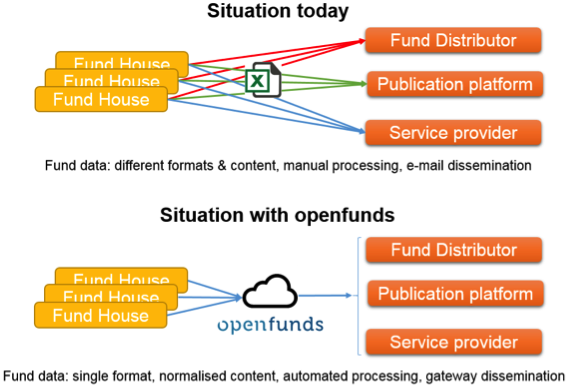Openfunds launches global standard for fund data interchange

Michael Partin, fundinfo: “openfunds is a cost-free standard for the precise description of investment funds.”
Zurich-based non-profit organisation, openfunds, has created a global standard for the characterisation of investment funds.
The goal of the new standard is to improve efficiency, transparency and reliability by eliminating potential sources of error and ambiguity during fund data interchange.
Openfunds is now calling for a global adoption of the standard.
The standard is published on the openfunds website and can be used by anyone free of charge.
Why?
At present, investment fund data is often sent from fund providers to their distribution partners in an archaic fashion: via Excel spreadsheets. Predictably, this can lead to duplication and errors at the fund provider’s end given that the individual spreadsheets are usually created manually for each distributor.
Also, the current fields leave room for interpretation. This results in inefficiencies, errors and ambiguities during data transfer, needing reconciliation between fund providers and their distribution partners.
Incomplete or erroneous fund data can have serious – and negative – consequences, i.e. investors may choose not to invest in the fund.
To resolve the issue, three financial services firms – fundinfo, Credit Suisse and UBS – put their heads together last year, and thus openfunds was born.
“Over time, other business partners and fund houses agreed that this was an idea whose time had come; today we have 28 supporters who have all agreed to conform to the openfunds standard,” says Michael Partin, CIO and partner at fundinfo.
“After a year and a half of collecting input and developing the standard, we are proud to announce the launch of openfunds version 1.0, a cost-free standard for the precise description of investment funds.”
How?
Openfunds will provide “a common, normalised standard for the autonomous collection, processing and exchange of fund data between fund houses and fund distributors”.
At the heart of it are unique data identifiers (data-IDs), all in the same format:
- A unique 10-character alpha-numeric number associated with each data-ID.
- Field name: the descriptive name of the data-ID.
- Field tags: each openfund field may be tagged with one or more field tags, e.g. “purchase information”, “taxes”, “KID” etc.
- Field level: level that the specific data-ID belongs to, e.g. “umbrella”, “company”, “share class” etc.
- Link reference: if a value change in one field leads to a change of a value in another field, the two fields are linked. If it is a loose link, openfunds calls the fields “dependent”; if it is strict, openfunds marks them as “linked fields”.
- Data type: either a text string, Boolean value (yes/no), or date (YYYY-MM-DD).
- Introduced with version: which version of openfunds this data-ID first appeared.
- Description.
- Values: possible values for this Data-ID.
- Examples.
Openfunds version 1.0 has nearly 200 data fields.
The initiative is not static, emphasises Partin. “With the ever-increasing requirements for better customer service and changing national regulations, openfunds will continue to evolve,” he says.
For instance, there are plans to add the dynamic fund data, such as NAV price, to the standard.

Fabio Pérez Cina, Credit Suisse: “openfunds will provide complete transparency in the global fund markets.”
The final frontier
“Like any standard, the benefits grow the more broadly it is adopted,” says Fabio Pérez Cina, head of fund lab and data team, investment solutions and products department at Credit Suisse.
“Take networking standards, for example. USB, Ethernet, photovoltaic-systems, etc. all support plug and play interoperability between devices manufactured and used anywhere in the world.
“Similarly, openfunds will bring the maximum benefit when, for example, a fund house based in London is able to disseminate all its fund data to Asian fund-distributors automatically and without the need for human intervention.
“Openfunds will provide complete transparency in the global fund markets, making it easy for all involved parties to understand and compare fund data coming from anywhere on the planet.”
The standard has achieved “critical mass” in Europe, he says, particularly in Germany, Switzerland, France, Spain and the UK. In-roads are being made in Asia where it is being adopted first in Hong Kong and Singapore.
“The US, which has additional layers of regulatory barriers, will be the ‘final frontier’ for openfunds,” he adds.
Call to action
Fundinfo’s Partin emphasises that particular attention was paid to keep openfunds as close as possible to existing workflows – making it “very easy” to adopt.
“We are fully aware, however, that it takes development resources to integrate openfunds in all of an organisation’s database systems,” Partin notes.
“The investment is well worth the payoff,” he urges. “Benefits are manifold and vary from higher efficiency and speed of data processing and dissemination, to vastly improved data quality.”
What’s openfunds?
Openfunds is a non-profit international consortium of financial institutions collaborating on a common industry standard for the interchange and dissemination of fund data.
It was set up in 2015.
As mentioned above, it is currently supported by 28 organisations, including well-known players such as Old Mutual, Julius Baer, Principal Global Investors and Bellevue Asset Management, in addition to the aforementioned Credit Suisse, UBS and fundinfo.
Specialist software providers Kurtosys and Cleversoft are also on the supporters list.












































